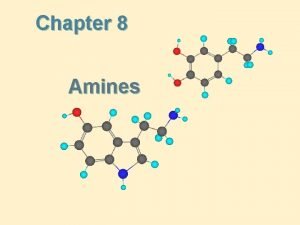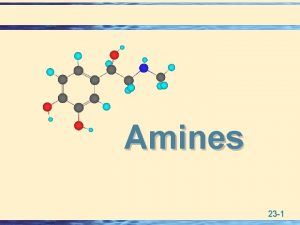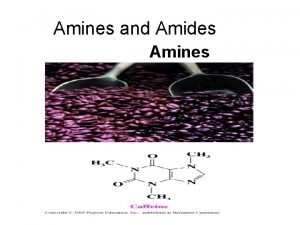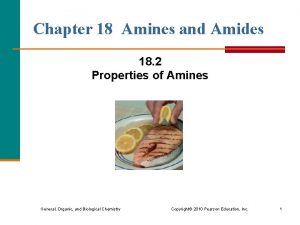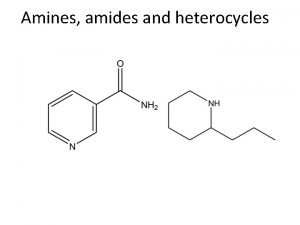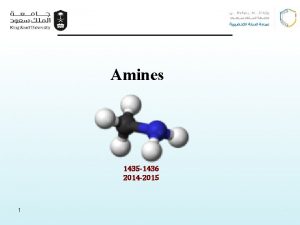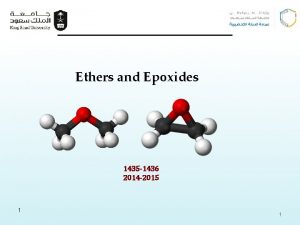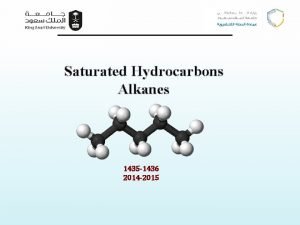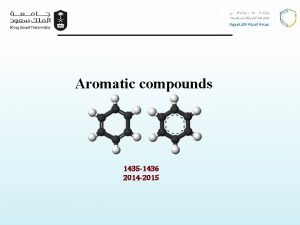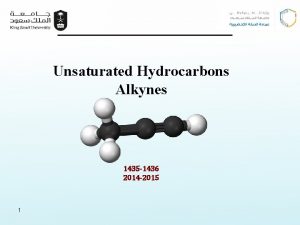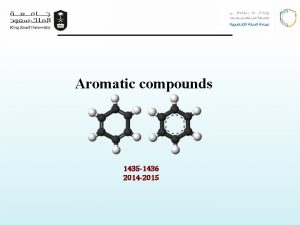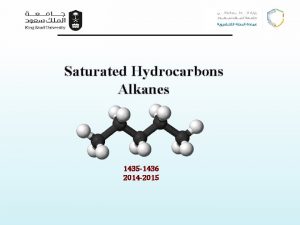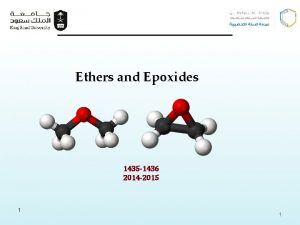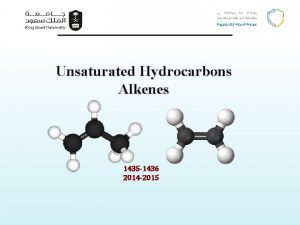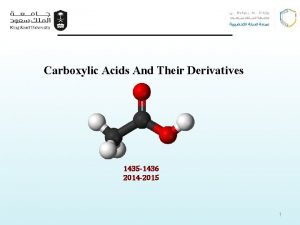Amines 1435 1436 2014 2015 1 1 Amines













- Slides: 13

Amines 1435 -1436 2014 -2015 1 1

Amines Learning Objectives Chapter ten discusses the following topics and by the end of this chapter the students will: Ø Know the structure and classification of amines Ø Know the naming rules for amines & precedence order of functional groups in compounds have more than one functional group. Ø Know the physical properties of amines Ø Know the effect of lone pair of electrons of N atom on basic properties of amines ØKnow the different methods used in synthesis of amines Ø Know the reactions of amines; in addition to behaving as bases amines can be nucleophiles. 2 145 Chem.

Amines Structure & Classification Amines are derivatives of ammonia that have one or more of the hydrogen replaced with alkyl and/ or aryl group. Amines: are a class of organic compounds that contain the N group Amines are formed in many biological systems. So it used as drugs and medicines. Classification Of Amines H R N: R primary (1 o) amines secondary (2 o) amines R N: R tertiary (3 o) amines 3 145 Chem.

Amines Common Nomenclature Of Amines Ø The common names of amines are derived by listing the name (s) of the group (s) surrounding the nitrogen (in alphabetical order) and adding the suffix amine. (N. B. if two vowels come together ; the first must be omitted e. g. ethanamine. Ø Symmetrical 2° & 3° amines (i. e. the substituents surrounding the N atom are identical) are named by adding the multiplication prefix (di or tri) to the name of the alkyl group. Methylamine Benzyl methyl amine Trimethyl amine Ø Structures with higher priority groups, the NH 2 group is called amino 4 145 Chem.

Amines IUPAC Names Of Primary Amines Ø If the compound does not contain a functional group except amino group, then the compound is named by finding the longest alkane chain containing the amino group and replacing the e in the IUPAC name by the suffix amine Ø However if the compound contain other functional groups then the order of precedence determines which group are named with prefix or suffix. (see the precedence table on slide 6) ØThe highest precedence group takes the appropriate suffix with all other groups taking the prefix (es), however = or Ξ bonds only take suffix form (ene, yne respectively. 5 -Methyl-3 -hexanamine 5 -Aminoheptanoic acid 3 -Amino-2 -butanol 5

Amines Precedence Order of Functional Groups (Descending Order) Class Functional group Prefix suffix Carboxylic acids Cyclic alknes or alkenes with COOH group COOH Aldehydes Cyclic alknes or alkenes with CHO group -CHO Formyl al carbaldehyde ketone -C=O oxo one Alcohols -OH hydroxy ol Amines -NH 2 amino amine Ethers -OR alkoxy - Alkenes and a. Alkynes & =Ξ bonds - ene & yne oic acid carboxylic acid 6 145 Chem.

Amines Naming Of Aromatic Amines ØThey have common names accepted by the IUPAC system, but if the benzene ring contain groups of higher priorities (COOH > CHO > C=O > OH > NH) in this case the amino group is added as a prefix. Pyridine Aniline Benzenamine o-Nitroaniline p-Toluidine p-Aminophenol 4 -Methyl benzenamine 7 145 Chem.

Amines Physical Properties of Amines 1) Boiling point : Ø Because they possess a polar N-H bond, primary and secondary amines are capable of forming intramolecular hydrogen bonds among their molecules; therefore they have: higher boiling points than alkanes but lower than alcohols (alcohols form stronger H-bonds than amines). ØTertiary amines can not form H-bonds among their molecules and their molecules are more branched thus they have the lowest boiling points among amines. 8 145 Chem.

Amines 2) Solubility : Ø All amines are capable of forming hydrogen bonds with water, alcohol (hydroxylic solvent) , thus they are soluble in water. ØThe lower molecular weight amines with up to six carbons show appreciable solubility in water. 3) Basicity Of Amines basic because N (nitrogen atom )has non bonded pair of electrons which can be donated to an acid to form ammonium salt. Base strength : ØAromatic amines less basic than aliphatic amines due to lone pair of electrons on N is involved in aromaticity Ø Electron donating (releasing) groups on N atom increase the basicity ØElectron withdrawing groups decrease the basicity 9 145 Chem.

Amines Preparation Of Amines 1) Alkylation of Ammonia: 2) Reduction of Nitro groups: 3) Reduction of Nitriles: 4) Reduction of Amides: 10 145 Chem.

Amines Reaction of Amines • Salts Formation: • Amides Formation: • Imines Formation: • Diazonium Salts Formation: Diazonium salt (benzene diazonium chloride) 145 Chem. 11

Amines Questions • • Write the structure of p-nitrobenzylamine? How to prepare ethylamine from acetamide? Why are aliphatic amines is more basic than aromatic amines? Select the stronger base from each pair of compounds? 12 145 Chem.

Amines Thank You for your kind attention ! Questions? Comments 13
 Basicity of amines
Basicity of amines Classification of amines
Classification of amines Aliphatic amines
Aliphatic amines Rd 1435/1992
Rd 1435/1992 Container vegetable gardening in arizona
Container vegetable gardening in arizona Sympathomimetic drugs classification
Sympathomimetic drugs classification Cyclic amine
Cyclic amine Base conjuguée
Base conjuguée Do aromatic amines give hinsberg test
Do aromatic amines give hinsberg test Amines hydrogen bonding
Amines hydrogen bonding Vital + amine
Vital + amine Are amines soluble in water
Are amines soluble in water Amines vasoactives
Amines vasoactives Aniline reacts with bromine water at room temperature
Aniline reacts with bromine water at room temperature
